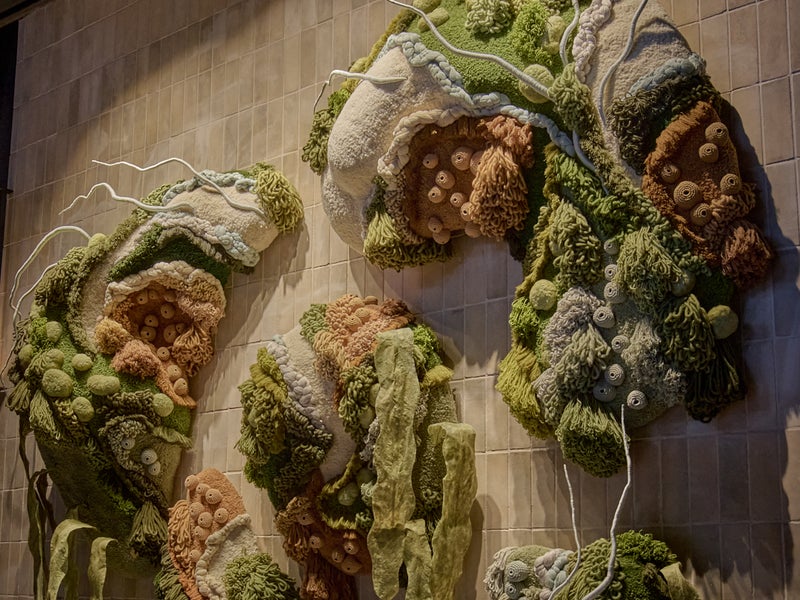A Creative Journey Through 1 Hotel Melbourne
Enter a space shaped by cycles of renewal and creativity, where Melbourne’s industrial past becomes the foundation for an artful, sustainable future.

At 1 Hotel Melbourne, art is not an afterthought, it’s a philosophy. Rooted in the concept of regeneration, the hotel’s art program explores the cycles of renewal, resilience, and transformation that shape both nature and culture. Built within the restored Goods Shed No.5 along the Yarra River, the hotel stands at a uniquely Melbourne intersection: where industry meets artistry, where heritage embraces innovation, and where the environment becomes both inspiration and collaborator.
“Regeneration is an essential component of the guest experience, where art and hospitality come together,” says David Lee from our partners at Riverlee. “Our dedication to the art program reflects our commitment to creating meaningful experiences, where nature, culture, and design intertwine.”
That vision became REGENERATION: The Art of Renewal, a curatorial collaboration between Riverlee, One Design Office, and DarkLab. Guided by One Design Office as both curators and interior designers, the collection was shaped as a quiet resistance to excess, favoring soul over spectacle.
True to the ethos of 1 Hotels, each artwork is site-specific, sustainably crafted, and rooted in place. Woven through the lobby, restaurant, and event spaces, the installations reflect the brand’s commitment to local storytelling and thoughtful design. Together, they invite guests to slow down, look closer, and reconnect with the land, the culture, and the spirit of 1 Hotel Melbourne.
Salted Souls by Vanessa Barragão
Greeting guests at the reception, this richly textured wool tapestry by Portuguese artist Vanessa Barragão draws inspiration from Victoria’s rockpools and seaweed formations. Crafted entirely by hand using crochet, felting, and 60kg of upcycled textile waste, this richly textured tapestry pays homage to Victoria’s coastal landscapes, evoking the seaweed formations and vibrant rockpools that define the region. Portuguese artist Vanessa Barragão named the piece Salted Souls to evoke the lasting impressions that landscapes and experiences leave on us, like salt crystallizing over time.
Salted Souls feels both ancient and alive. What drew you to the textures and rhythms of Victoria’s coastline as your starting point?
Even though I didn’t visit Victoria during my trip to Australia, I was really inspired by the photos I saw of the coastline. The colours, the shapes of the seaweed, and the small ecosystems in the rockpools felt so full of life and movement. They made me think about how the sea and land are always changing, but still hold something timeless. That feeling stayed with me. Salted Souls was my way of connecting with that part of Australia of showing how nature can touch us deeply, even from far away.
Your use of upcycled materials transforms waste into something tactile and intimate. What stories do you think discarded fibres can tell when given a second life?
I think waste materials have a hidden story. They were made with a purpose, then forgotten. When I work with these fibres and bring them into new artworks, it feels like giving them a voice again. It’s a way to show that beauty can come from what we throw away. These materials carry stories of transformation. They show that we can create with purpose, respecting the world around us.
Syntheses by Jamie North
In the hotel’s light-filled lobby, Jamie North’s eroded concrete columns blur the line between architecture and sculpture. Two towering columns of eroded concrete, slag, and native plants mirror the structural supports of the hotel itself, evoking a poetic dialogue between built form and natural regeneration. The rawness of exposed steel rebar and the softness of plant life create a sensory meditation on time, sustainability, and adaptation with native Australian plants continuing to grow and gradually claim more of the structure, transforming the piece continuously over time.
These columns feel like memory made material—weathered, rooted, and alive. How did you think about time as a collaborator in this work?
Time is an essential collaborator in all my work, but particularly with these columns. I think of them less as static objects and more as ongoing processes - structures that are incomplete without the slow, continuous influence of time. The materials themselves -concrete, blast furnace slag, native plants - already carry histories within them. They're fragments of ecological and industrial timelines.
You’ve called your work a “dialogue” between architecture and nature. What were those conversations like while creating Syntheses for this space?
In Syntheses, the dialogue between architecture and nature was shaped as much by the site as by the materials themselves. This particular space carries its own memory—once a working wharf, now layered with reused materials from both nearby and further afield. That material history became part of the conversation, and I wanted the work to respond to that.
The columns are a kind of echo of the architectural language of the site. They directly mimic the structural columns that sit alongside them, though I have sculpturally eroded them and added complexity, allowing them to become animated by plant life. They acknowledge the built environment while allowing for something organic to persist and take hold.
Suspended Landscapes by Jamie North
In the hotel’s restaurant, Jamie North returns with a sculptural room divider that feels more like a living landscape. Using cast concrete forms made from a mixture incorporating blast furnace slag, coal ash and scoria rock, stones the rock forms appear to hover in mid-air with climbing plants establishing themselves below, inviting the natural world to interact with the built one. Native vines wrap around rebar supports, shifting the space as they grow—a quiet, ongoing act of renewal.
Suspended Landscapes seem to hover between states—weight and weightlessness, ruin and renewal. How did you find balance in that tension?
Suspended Landscape was about holding opposing forces in tension—both materially and conceptually. The cast concrete rocks evoke mass, ruin, and industrial residue, yet lifting them on reinforcing bars lets them hover, momentarily weightless. That contradiction is central to the work. I wasn’t trying to resolve it, but to give it form—to let the sculpture exist in that charged, in-between space. The plants are key to this. As they wind through the rocks and steel, they introduce softness, fragility, and time. They both bind and disrupt the composition. In this unstable ecology, the rocks are not inert; they carry potential—not just as symbols of collapse, but as sites for regeneration. It’s in this zone between ruin and renewal, heaviness and suspension, that the work begins to feel alive.
What role does slow transformation (like the growth of native vines) play in your creative process?
Slow transformation is at the core of my creative process. In Suspended Landscape, and more broadly in my work, I’m not just creating static forms, I’m building sculptural systems designed to support plant life over time. The growth of native vines, for instance, isn’t an afterthought or embellishment; it’s integral to the work’s realisation. Their slow, unpredictable movement becomes a form of mark-making that activates and alters the sculpture long after it leaves the studio.
When I’m thinking through a sculpture, I try to shift perspective—to consider what the work needs from a non-human point of view. What conditions will allow the plants to take hold, to persist, to thrive? That kind of thinking transforms the sculptural process. It becomes less about imposing form and more about creating a structure that can accommodate growth, and change.
Milŋiyawuy – The Milky Way by Naminapu Maymuru-White
Seven hand-painted Larrakitj memorial poles rise beside the staircase, rendered in traditional Yolŋu earth pigments. Their celestial design references the Milky Way and ancestral songlines, connecting the cosmos to the Birrarung (Yarra River). This installation bridges Indigenous knowledge, spiritual memory, and place-based storytelling, grounded by pebbles from Arnhem Land. The installation holds a spiritual connection to Country, grounding this celestial story in both place and presence.
How do you approach creating work that is both a spiritual offering and a contemporary public installation?
“These paintings show the sacred songs story about the establishment of my homeland Djarrakpi for the Maŋgalili clan in ancient times. This was given to me by my father, and he told me to hold it strong and to pass it on. This is what I have been doing. This is not just a pretty picture or a nice story. This is the truth. It is a reality for us. I am inspired every day by the beauty of the world around me and the stars themselves. I paint what is true. I feel this sacredness. I am painting to try and share that feeling with people who don’t know about it. I want them to feel how special this is.”
The Ray Fin by Yhonnie Scarce
Suspended overhead, 1,100 hand-blown glass elements shimmer in glancing light. This ethereal piece honors the migration of the glass eels from the sea to the freshwater of the Birrarung, whose resilience and shapeshifting forms embody survival and transformation. Indigenous artist Yhonnie Scarce draws on deep connections to Country, reflecting on how traditional knowledge adapts and endures within modern landscapes.
The Ray Fin captures the eel’s resilience and mystery. What did you want this migration story to awaken in viewers?
It is important to note how much activity occurs beneath the surface of our waterways. Sea life like the glass eels travel great distances to reach their destination, often dealing with marine debris, predators and the fishing industry.
Glass eels are resilient creatures and ‘fly’ under the radar when migrating and I am in complete awe of their brilliance. They adapt to their surroundings and can travel on land once they mature. I hope viewers can see how important they are and to get a sense of how the artwork reflects the movements of such a wonderful being.
Glass is both fragile and sharp. How does this material choice mirror the histories and ecologies you often explore in your work?
Glass is often seen as a fragile material, but I think it is a powerful medium to represent Aboriginal people. Glass represents resilience, beauty and strength in the work that I produce. At the end of the day, it is who we are, it is how we practice culture and despite dealing with the ongoing effects of colonisation, we are still here.
A Creative Ecosystem Rooted in Place
The art program at 1 Hotel Melbourne reflects a city known for its creative edge and environmental consciousness. But more than that, it reflects a philosophy: that beauty can emerge from what’s left behind, that culture is a living system, and that hospitality can be a form of storytelling.
Each artwork is a thread in the larger fabric of the hotel—an invitation to see, feel, and think differently about the spaces we inhabit and the world we’re helping to shape. At 1 Hotel Melbourne, we invite you to stay, slow down, and reconnect—not just with our walls, but with the land and stories that breathe life into them.












